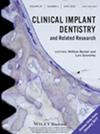A Randomized Controlled Trial on the Timing of Soft Tissue Augmentation in Immediate Implant Placement: Soft Tissue Changes and Esthetic Outcome
Abstract
Aim
To assess the impact of the timing of soft tissue augmentation on soft tissue changes and esthetic outcome following single immediate implant placement (IIP) in the anterior maxilla.
Materials and Methods
Patients with a failing tooth and intact buccal bone wall in the anterior maxilla (15–25) were enrolled in this RCT. Following single IIP and socket grafting, they were randomly allocated to the control group (immediate soft tissue augmentation performed in the same surgical procedure—ISTA) or the test group (delayed soft tissue augmentation performed 3 months later—DSTA). Implants were placed with a surgical guide and immediately restored with an implant-supported provisional crown. Changes in soft tissue dimensions were assessed by a blinded clinician using superimposed STL files taken prior to surgery and at 1-year follow-up. The esthetic outcome was rated by a blinded clinician and the patient at 1-year follow-up. The study adhered to the STA-COSM (Soft Tissue Augmentation—Core Outcome Set and Measurements for implant dentistry trials) guidelines.
Results
Twenty patients were randomized to each group (control: 16 females, 4 males, mean age 57.6; test: 9 females, 11 males, mean age 54.2). The mean change in buccal soft tissue profile was −0.251 and 0.083 mm for ISTA and DSTA, respectively. The mean difference of −0.318 mm in favor of DSTA was not significant (95% CI: −0.860 to 0.224, p = 0.241). Median midfacial recession was −0.200 and − 0.350 mm for ISTA and DSTA, respectively. The median difference of 0.200 mm in favor of ISTA was not significant (95% CI: −0.210 to 0.700, p = 0.311). Mesial and distal papillary recession, Pink Esthetic Score and patients' esthetic satisfaction failed to demonstrate a significant difference between the groups.
Conclusion
In patients with an intact buccal bone wall, the timing of soft tissue augmentation following IIP had no significant impact on soft tissue changes and esthetic outcome.
Trial Registration: ClinicalTrials.gov: NCT05537545

 求助内容:
求助内容: 应助结果提醒方式:
应助结果提醒方式:


